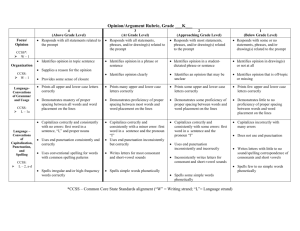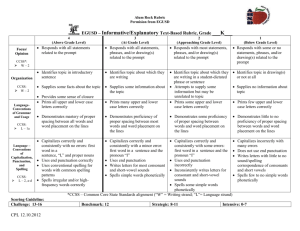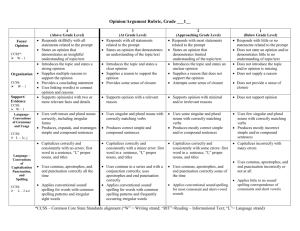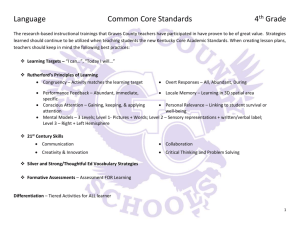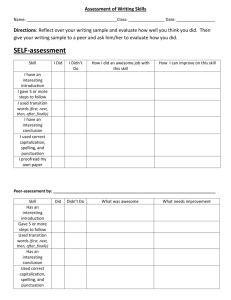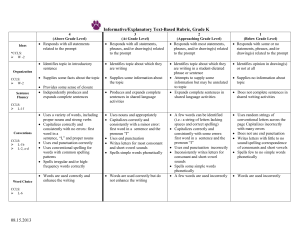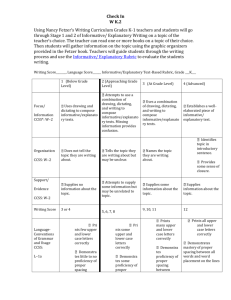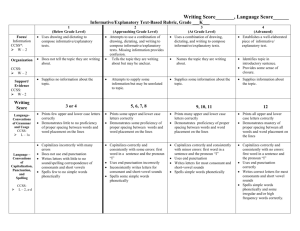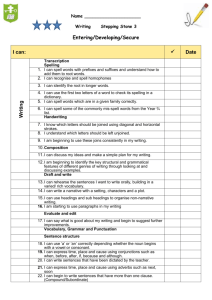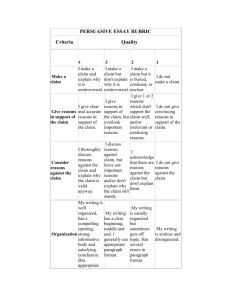Opinion
advertisement
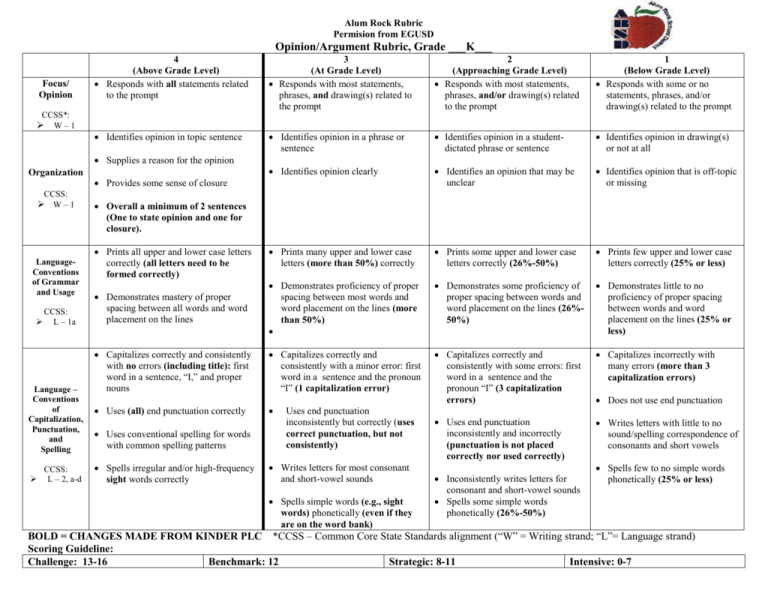
Alum Rock Rubric Permision from EGUSD Opinion/Argument Rubric, Grade ___K___ Focus/ Opinion 4 (Above Grade Level) Responds with all statements related to the prompt 3 (At Grade Level) Responds with most statements, phrases, and drawing(s) related to the prompt 2 (Approaching Grade Level) Responds with most statements, phrases, and/or drawing(s) related to the prompt 1 (Below Grade Level) Responds with some or no statements, phrases, and/or drawing(s) related to the prompt Identifies opinion in topic sentence Identifies opinion in a phrase or sentence Identifies opinion in a studentdictated phrase or sentence Identifies opinion in drawing(s) or not at all Identifies opinion clearly Identifies an opinion that may be unclear Identifies opinion that is off-topic or missing Prints many upper and lower case letters (more than 50%) correctly Prints some upper and lower case letters correctly (26%-50%) Prints few upper and lower case letters correctly (25% or less) Demonstrates mastery of proper spacing between all words and word placement on the lines Demonstrates proficiency of proper spacing between most words and word placement on the lines (more than 50%) Demonstrates some proficiency of proper spacing between words and word placement on the lines (26%50%) Demonstrates little to no proficiency of proper spacing between words and word placement on the lines (25% or less) Capitalizes correctly and consistently with no errors (including title): first word in a sentence, “I,” and proper nouns Capitalizes correctly and consistently with a minor error: first word in a sentence and the pronoun “I” (1 capitalization error) Capitalizes incorrectly with many errors (more than 3 capitalization errors) Uses (all) end punctuation correctly Capitalizes correctly and consistently with some errors: first word in a sentence and the pronoun “I” (3 capitalization errors) Uses end punctuation inconsistently and incorrectly (punctuation is not placed correctly nor used correctly) Writes letters with little to no sound/spelling correspondence of consonants and short vowels CCSS*: W–1 Supplies a reason for the opinion Organization Provides some sense of closure CCSS: W–1 LanguageConventions of Grammar and Usage CCSS: L – 1a Language – Conventions of Capitalization, Punctuation, and Spelling CCSS: L – 2, a-d Overall a minimum of 2 sentences (One to state opinion and one for closure). Prints all upper and lower case letters correctly (all letters need to be formed correctly) Uses conventional spelling for words with common spelling patterns Spells irregular and/or high-frequency sight words correctly Uses end punctuation inconsistently but correctly (uses correct punctuation, but not consistently) Writes letters for most consonant and short-vowel sounds Spells simple words (e.g., sight words) phonetically (even if they are on the word bank) Inconsistently writes letters for consonant and short-vowel sounds Spells some simple words phonetically (26%-50%) Does not use end punctuation Spells few to no simple words phonetically (25% or less) BOLD = CHANGES MADE FROM KINDER PLC *CCSS – Common Core State Standards alignment (“W” = Writing strand; “L”= Language strand) Scoring Guideline: Challenge: 13-16 Benchmark: 12 Strategic: 8-11 Intensive: 0-7 CA Common Core State Standards (CCSS) Alignment NOTES: In the left criterion boxes of the rubric, the CCSS-aligned standards have been identified. As a resource for teachers, below are the standards for the current grade (K) as well as the subsequent grade. Since the rubric score of “4” represents “above grade level” work, the 1st grade standards were referenced. The letter abbreviations are as follows: Strand (Domain) Writing LanguageConventions of Grammar and Usage CCSS = Common Core State Standards W = Writing Kindergarten L=Language 1st 1. Use a combination of drawing, dictating, and writing to compose opinion pieces in which they tell a reader the topic or the name of the book they are writing about and state an opinion or preferences about the topic or book (e.g., My favorite book is…). 1. Write opinion pieces in which they introduce the topic or name the book they are writing about, state an opinion, supply a reason for the opinion, and provide some sense of closure. 1. Demonstrate command of the conventions of standard English grammar and usage when writing or speaking. 1. Demonstrate command of the conventions of standard English grammar and usage when writing or speaking. (Note – these standards correspond in order to how they are arranged in the last box of the table.) Language – Conventions of Capitalization, Punctuation, and Spelling 2. Demonstrate command of the conventions of standard English capitalization, punctuation, and spelling when writing. a. Capitalize the first word in a sentence and the pronoun I. b. Recognize and name end punctuation. c. Write a letter or letters for most consonant and short-vowel sounds (phonemes). d. Spell simple words phonetically, drawing on knowledge of sound-letter relationships 2. Demonstrate command of the conventions of standard English capitalization, punctuation, and spelling when writing. a. Capitalize dates and names of people. b. Use end punctuation for sentences. d. Use conventional spelling for words with common spelling patterns and for frequently occurring irregular words. e. Spell untaught words phonetically, drawing on phonemic awareness and spelling conventions.
